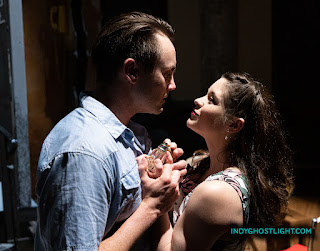Power of four: Nina Simone's artistic struggle mirrors barriers to Black survival
Many years ago, an Indianapolis Star colleague gave me a mixtape he had put together focusing on Nina Simone. To be sure, Mpozi Mshale Tolbert and I didn't know each other well, but his iconic status as a leading light of urban culture has long been clear to me. I was surprised and grateful for the gift, yet this open-hearted photojournalist and DJ had a reputation for such gestures.
 |
| Like points of the compass, four women define a world in new IRT production. |
The label of '"iconic" has been overused recently, but Mpozi justifiably retains that status to this day, partly as a result of the shocking erasure of a memorial mural in Broad Ripple honoring him, then its restoration years later.
He struck a chord that still resonates. Certainly "Mpozi Lives" made no idle, defiant graffiti appearance along the way. He died young, at 34, having moved to this city in 1990s and quickly grown in stature (he was already quite tall physically).
I put that mixtape in a special place at home, but alas, as is often the
 |
| Akili Ni Mali (right) represents Nina Simone's artistic vision. |
case when we put things in special places, we gradually have no sense of where that special place is. I carry that mixtape in my heart, and I mention it here because the gift came back to me when I attended the opening night of "Nina Simone: Four Women" at Indiana Repertory Theatre.
Before the mixtape, I was familiar with Nina Simone's music, thanks to its occasional inclusion in a jazz radio show I used to listen to as a teenager in Michigan. Nina Simone was not a jazz artist, but her genre-blurring style could readily find a place on jazz radio. She was somewhat a pop artist with a singer-songwriter sensibility; there was also a cabaret-style overlay of theatrical projection centered on a race-consciousness that was unapologetically confrontational.
Her command of the keyboard (approximated in this show with vigor and sensitivity by music director Morgan E. Stevenson) was vast and served her creative needs readily. And her voice was powerful, drawing on the music of the black church, but largely without much ornamentation of the vocal line. (That legacy in this show is represented chiefly by Jamecia Bennett as Sarah, who drew vocal acclaim from the audience while performing "His Eye Is on the Sparrow" and other songs.)
Treated to IRT's characteristically thorough and revealing production design, Christina Ham's sturdy, moving one-act play puts Simone in a dream-cum-nightmare setting of her home up north and the partially destroyed 16th Street Baptist Church in Birmingham, Ala. That's where a racist bombing killed four girls on September 15, 1963. The play takes place the next day, with Simone in a creative frenzy. It details the musician's confrontation with three other black women who coalesce into the figures she represented in her song "Four Women." Also symbolic of Simone's anti-racist ferocity is the song 'Mississippi Goddam," her response to the assassination earlier that year of Medgar Evers in his Jackson driveway.
The dialogue at first, with Sarah, a pious domestic worker somewhat skeptical of Nina's militancy, lays out their contrasting perspectives. Though well-performed, it seemed to follow conventional lines of exposition and debate, and the show took a while to find its dramatic heart.
When Sephronia (Aeriel Williams) enters, self-conscious about her "high-yaller" status and triangulating the perspectives of Sarah and Nina (Akili Ni Mali, rising to every challenge) by justifying her activism, all that changed in Friday's performance. The blossoming of the struggle, both ideological and personal, is completed when the streetwalker known as Sweet Thing (Precious Omigie) storms onto the set, armed and dangerous, ready to deal with all attitudes and poses displayed thus far.
Names and other signifiers of identity are crucial to the show. It's a feature of black life that James Baldwin highlighted by titling his second essay collection "Nobody Knows My Name" (1961). What are these women trying to be, and who are they allowed to be? It all comes home with the final song, "Four Women," staged with eloquent movement by the show's director, Austene Van. Simone's classic performance of that piece has the four women ending each self-description by roaring her name. "My name is Peaches!' is an ear-worm I never mind having.
Before that, the dramatic climax of the play is the company "shout" that occasions the greatest outburst of women dancing in ecstasy I have seen at IRT since "The Dancing at Lughnasa" during the Libby Appel era. Both are now ensconced among the most uplifting scenes in my IRT memory bank. And I can't find the program book for that show any more than I can the (more precious) mixtape I got from Mpozi. Sometimes a spotty recall just has to serve.
[Photos by Zach Rosing]




Fantastic post! Nina Simone’s artistry and influence continue to inspire generations with her powerful music and fearless expression. Just as music conveys emotion and storytelling, visual imagery plays a crucial role in capturing attention and conveying messages effectively. Professional posed model imagery service ensures that models are presented with the perfect pose, lighting, and composition to create striking visuals for fashion, advertising, and branding. High-quality imagery enhances storytelling, much like Simone’s music does through sound. Thanks for this insightful read! Looking forward to more engaging content from you.
ReplyDelete